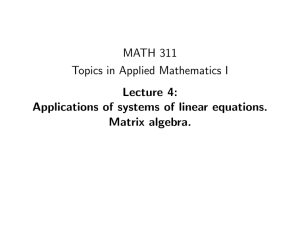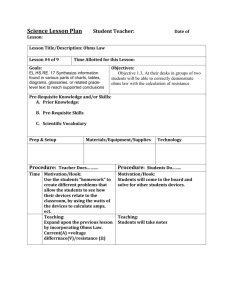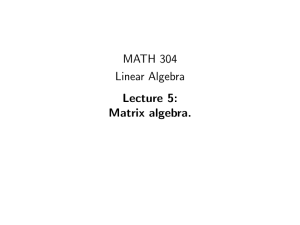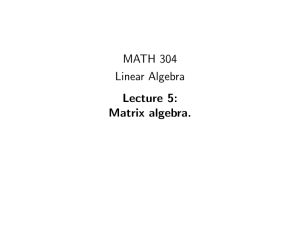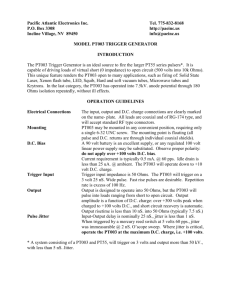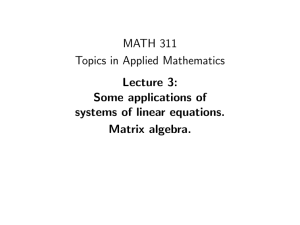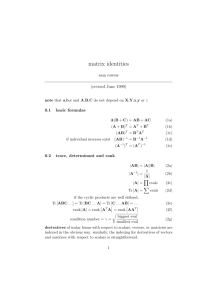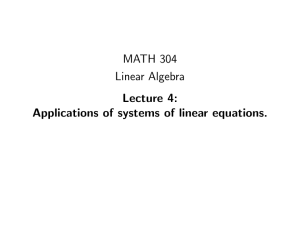Math 304–504 Linear Algebra Lecture 4: Another application
advertisement
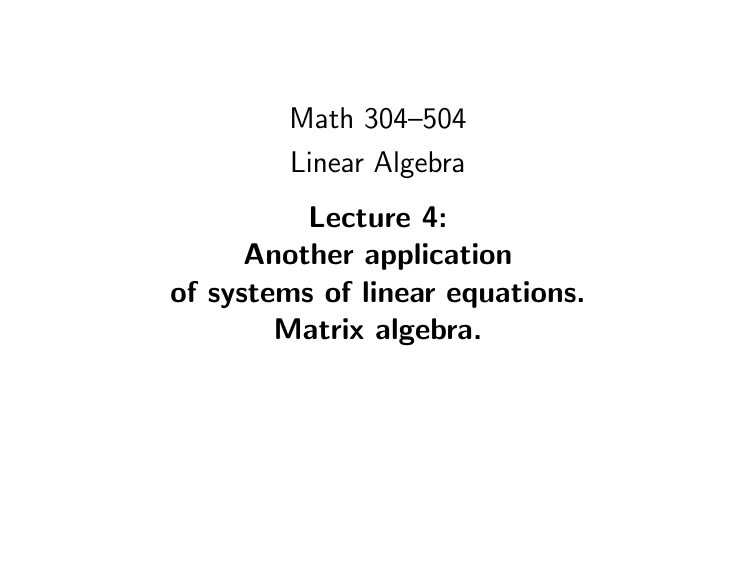
Math 304–504 Linear Algebra Lecture 4: Another application of systems of linear equations. Matrix algebra. Electrical network 9 volts 4 ohms 1 ohm 3 ohms 2 ohms 4 volts Problem. Determine the amount of current in each branch of the network. Electrical network i1 9 volts 4 ohms 1 ohm i2 3 ohms 2 ohms 4 volts i3 i1 =?, i2 =?, i3 =? Electrical network i1 9 volts 4 ohms 1 ohm i2 3 ohms 2 ohms 4 volts i3 Kirchhof’s law #1 (junction rule): at every node the sum of the incoming currents equals the sum of the outgoing currents. Electrical network 9 volts i1 4 ohms 1 ohm i2 A B 3 ohms 2 ohms 4 volts Node A: Node B: i3 i1 = i2 + i3 i2 + i3 = i1 Electrical network Kirchhof’s law #2 (loop rule): around every loop the algebraic sum of all voltages is zero. Ohm’s law: for every resistor the voltage drop E , the current i, and the resistance R satisfy E = iR. Top loop: Bottom loop: Big loop: 9 − i2 − 4i1 = 0 4 − 2i3 + i2 − 3i3 = 0 4 − 2i3 − 4i1 + 9 − 3i3 = 0 Remark: The 3rd equation is the sum of the first two equations. i1 = i2 + i3 9 − i2 − 4i1 = 0 4 − 2i3 + i2 − 3i3 = 0 i1 − i2 − i3 = 0 4i1 + i2 = 9 ⇐⇒ −i2 + 5i3 = 4 Matrices Definition. An m-by-n matrix is a rectangular array of numbers that has m rows and n columns: a11 a12 a 21 a22 .. .. . . am1 am2 . . . a1n . . . a2n . . . ... . . . amn Notation: A = (aij )1≤i≤n, 1≤j≤m or simply A = (aij ) if the dimensions are known. An n-dimensional vector can be represented as a 1 × n matrix (row vector) or as an n × 1 matrix (column vector): x1 x 2 (x1 , x2 , . . . , xn ) .. . xn An m × n matrix A = (aij ) can be regarded as a column of n-dimensional row vectors or as a row of m-dimensional column vectors: v1 v 2 A = .. , vi = (ai1 , ai2 , . . . , ain ) . vm a1j a 2j A = (w1 , w2 , . . . , wn ), wj = .. . amj Vector algebra Let a = (a1 , a2 , . . . , an ) and b = (b1 , b2 , . . . , bn ) be n-dimensional vectors, and r ∈ R be a scalar. Vector sum: a + b = (a1 + b1 , a2 + b2 , . . . , an + bn ) Scalar multiple: Zero vector: r a = (ra1 , ra2 , . . . , ran ) 0 = (0, 0, . . . , 0) Negative of a vector: −b = (−b1 , −b2 , . . . , −bn ) Vector difference: a − b = a + (−b) = (a1 − b1 , a2 − b2 , . . . , an − bn ) Given n-dimensional vectors v1 , v2 , . . . , vk and scalars r1 , r2 , . . . , rk , the expression r1 v1 + r2 v2 + · · · + rk vk is called a linear combination of vectors v1 , v2 , . . . , vk . Also, vector addition and scalar multiplication are called linear operations. Matrix algebra Definition. Let A = (aij ) and B = (bij ) be m×n matrices. The sum A + B is defined to be the m×n matrix C = (cij ) such that cij = aij + bij for all indices i, j. That is, two matrices with the same dimensions can be added by adding their corresponding entries. a11 a12 b11 b12 a11 + b11 a12 + b12 a21 a22 + b21 b22 = a21 + b21 a22 + b22 a31 a32 b31 b32 a31 + b31 a32 + b32 Definition. Given an m×n matrix A = (aij ) and a number r , the scalar multiple rA is defined to be the m×n matrix D = (dij ) such that dij = raij for all indices i, j. That is, to multiply a matrix by a scalar r , one multiplies each entry of the matrix by r . a11 a12 a13 ra11 ra12 ra13 r a21 a22 a23 = ra21 ra22 ra23 a31 a32 a33 ra31 ra32 ra33 The m×n zero matrix (all entries are zeros) is denoted Omn or simply O. Negative of a matrix: −A is defined as (−1)A. Matrix difference: A − B is defined as A + (−B). As far as the linear operations (addition and scalar multiplication) are concerned, the m×n matrices can be regarded as mn-dimensional vectors. Examples 3 A= 1 2 C= 0 2 −1 2 0 1 , B= , 1 1 0 1 1 0 1 1 , D= . 1 0 1 5 2 A+B = 1 2 4 0 , 2C = 0 2 7 2C + 3D = 0 0 , 2 A−B = 3D = 3 , 5 1 2 −2 , 1 0 0 3 3 , 0 3 A + D is not defined. Properties of linear operations (A + B) + C = A + (B + C ) A+B =B +A A+O =O +A=A A + (−A) = (−A) + A = O r (sA) = (rs)A r (A + B) = rA + rB (r + s)A = rA + sA 1A = A 0A = O Dot product Definition. The dot product of n-dimensional vectors x = (x1 , x2 , . . . , xn ) and y = (y1 , y2 , . . . , yn ) is a scalar n X x · y = x1 y1 + x2 y2 + · · · + xn yn = xk yk . k=1 The dot product is also called the scalar product. Matrix multiplication The product of matrices A and B is defined if the number of columns in A matches the number of rows in B. Definition. Let A = (aik ) be an m×n matrix and B = (bkj ) be an n×p matrix. The product AB is defined be the m×p matrix C = (cij ) such that Pto n cij = k=1 aik bkj for all indices i, j. That is, matrices are ∗ ∗ ∗ ∗ ∗ * * * ∗ multiplied row by column: ∗ * ∗ ∗ ∗ ∗ ∗ ∗ * ∗ = ∗ ∗ * ∗ ∗ * ∗ v1 v 2 A = .. , . vm vi = (ai1 , ai2 , . . . , ain ); B = (w1 , w2 , . . . , wp ), b1j b 2j wj = .. . . bnj v1 ·w1 v1 ·w2 v ·w v ·w 2 1 2 2 =⇒ AB = .. .. . . vm ·w1 vm ·w2 . . . v1 ·wp . . . v2 ·wp .. . ... . . . . vm ·wp Examples. y1 y2 = (Pn xk yk ), (x1 , x2 , . . . , xn ) k=1 ... yn y1 y1 x1 y1 x2 . . . y1 xn y2 (x1 , x2 , . . . , xn ) = y2 x1 y2 x2 . . . y2 xn . .. .. ... ... ... . . yn yn x1 yn x2 . . . yn xn Example. 0 3 1 1 −3 1 3 0 1 1 −1 −2 5 6 0 = −3 17 16 1 0 2 1 1 7 4 1 Any system of linear equations can be rewritten as a matrix equation. a11 x1 + a12 x2 + · · · + a1n xn = b1 a21 x1 + a22 x2 + · · · + a2n xn = b2 ········· am1 x1 + am2 x2 + · · · + amn xn = bm a11 a12 a 21 a22 ⇐⇒ .. .. . . am1 am2 ... ... ... ... b1 x1 a1n a2n x2 b2 .. .. = .. . . . bm xn amn Properties of matrix multiplication: (AB)C = A(BC ) (associative law) (A + B)C = AC + BC (distributive law #1) C (A + B) = CA + CB (distributive law #2) (rA)B = A(rB) = r (AB) (Any of the above identities holds provided that matrix sums and products are well defined.) If A and B are n×n matrices, then both AB and BA are well defined n×n matrices. However, in general, AB 6= BA. 2 0 1 1 Example. Let A = , B= . 0 1 0 1 2 2 2 1 Then AB = , BA = . 0 1 0 1
